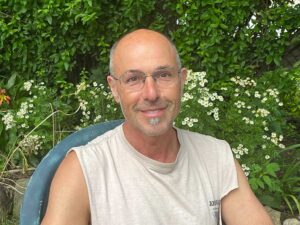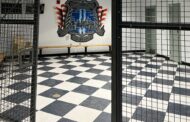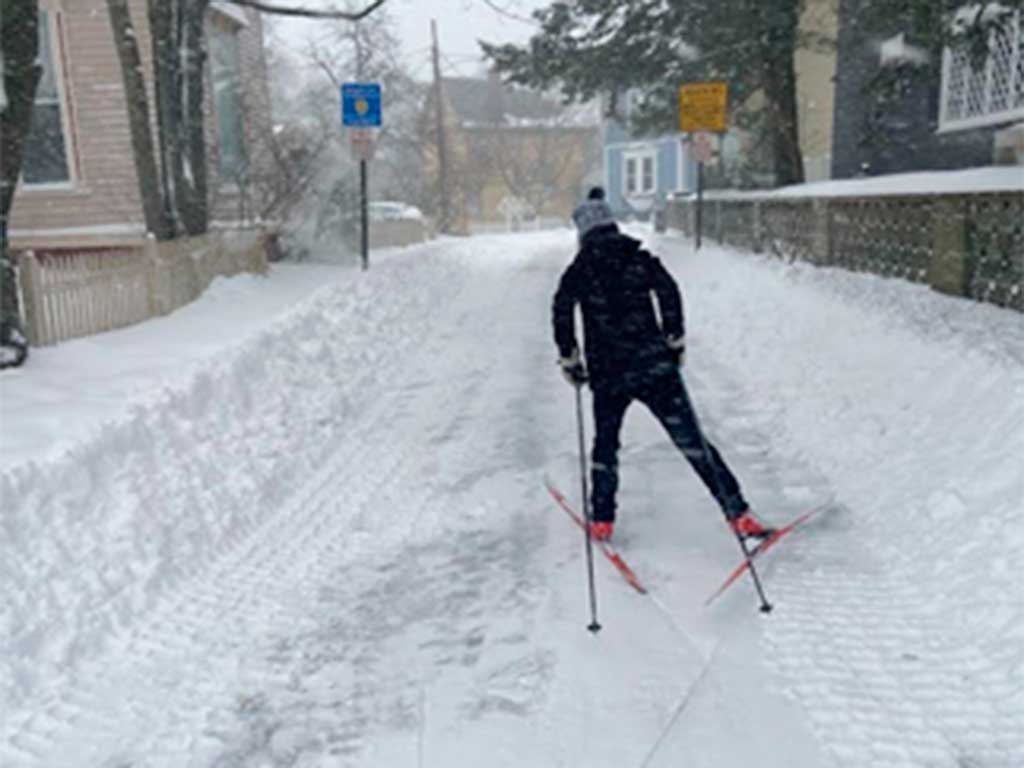
Markos Miller on Franklin Street: ‘Don’t close yourself off to who your allies might be!‘
Every month PelotonLabs co-founder Liz Trice interviews a local community member. This month, Liz caught up with Markos Miller, an educator and founding member of the Franklin Reclamation Authority, a community group with a mission to rebuild and repair the unfortunate design of Franklin Street, a.k.a. Franklin Arterial.
What got you started in this?

In 2005 I became the president of Munjoy Hill Neighborhood Organization. The city was finalizing its peninsula traffic study, which called for doubling the width of Franklin Street. I had thought about going back to grad school for urban planning but decided instead to dig in and get involved in local issues. I read the study, reached out to staff and councilors, built some community support, and got the plan delayed.
Then we realized we needed to create a better alternative. So we formed a group and called it the Franklin Reclamation Authority. We hosted a workshop with a short training on design and history of the site and broke people into small groups to create new designs. It was very constructive.
We shared our report with city manager Joe Gray, who, ironically, had started his career in Portland as a young planner working on Franklin. Joe Gray helped us find some funds to do a Phase 1 study with three alternative designs. Our task force met twenty-two times in a year and a half. People started to see Franklin could be different — not just a no-man’s-land filled with cars. Also, we had a huge design charette at Ocean Gateway with over one hundred people.
Tell me more about Phase 1.
This Phase 1 plan created three options. An Urban Street, pushing the two streets together. An Urban Parkway, pushing the lanes to one side and have a long lateral park from Back Cove to the waterfront. And an Urban Boulevard that had through traffic in the middle and side streets with slower traffic. But there were other ideas too, like building buildings in the median.
We shared our visions with PACTS and MDOT and GPCOG. They found a larger amount of money to do a Phase 2 with proper traffic engineering and a lot more people involved. That probably started in 2009 to 2015. We involved neighborhood and bike activists, and people wanting to make sure the cars could get into town as fast as possible. And we agreed on a plan that would free up five to six acres of land for redevelopment.

The vision was to have dense urban buildings and to reconnect as many of the cross streets as possible. And to restore the part of Lincoln Park that was chopped off when the Arterial was made. So that plan was adopted in 2015. I never thought I’d be involved with this for most of my adult life!
Why should people care about Franklin Street? What’s the history?
Portland is this great walkable city with architecture and history, and when you get to Franklin Street, it’s clear that something drastic happened here. The street network is disrupted, and there were no sidewalks up or down Franklin at the time we started. People cross illegally at the “desire lines” across the median… it was so incongruent with the rest of Portland. There’s lots of land, but you can’t use it and you can’t get to it safely. Having lived in other cities, and traveled, I knew that Franklin could be the kind of street that moves cars and is still a great place to work and live and hang out and play.
Redlining & Urban Renewal
In the early 1900’s, Franklin Street was a typical two-lane street neighborhood with mainly Jewish, Armenian, and Italian immigrants. The area was “redlined,” which means it was hard to get a loan to buy or fix up properties. After the Great Depression and World War II some buildings fell into decay. Wealthier families moved into the West End, and there were cheap loans for white people to move to the suburbs.
In the 1950s there was federal money to demolish slums, and the Franklin Street neighborhood, including Portland’s “Little Italy” was demolished. Then the 295 highway was built to bring the people who had moved to the suburbs back into the city for work.
What we see now is just the first phase of the “Patterns of Progress” plan by Victor Gruen, the inventor of the shopping mall. The plan was to have high-speed traffic going under Congress and Cumberland so that trucks and cars could get quickly down to the waterfront, and local streets parallel on either side. Cumberland and Spring streets were also part of the plan to create a highway ring road around the city. It stopped when West End residents realized that the ring road would also bulldoze part of their neighborhood and they put a stop to it.
It’s a story of political power. The immigrants and renters couldn’t stop their neighborhood being demolished, but wealthier residents in the West End could.
What’s happening now?
The city has recognized the need to move forward with the plan. They’ve created an RFP for an urban design consultant to revisit the plan and get it to a shovel ready status, so that it’s eligible for funding. New federal funds like the Reconnecting Communities program are coming, which is specifically for cities that were disrupted by urban renewal.
We have a group working to show the potential to build housing on the five acres of reclaimed land. Part of the Portland Housing Authorities’ plan is based on that reclaimed land adjacent to Franklin Towners, Kennedy Park, and the county courthouse. The community could decide which parcels to sell to private developers versus give to Portland Housing Authority or affordable housing developers. We’d love to see mixed use development!
When you think of Franklin as a place where thousands of people could be living, it becomes a neighborhood again instead of a mini-highway.
How can people get involved? What’s it been like to do this work?
You can contact councilors and city manager, and say you support the redesign of Franklin Street. And say you support as much housing as possible. You can share your vision.
I want there to be a public event that people can attend and say, “Hey! Let’s fix Franklin Street and build a bunch of housing!”
Markos, what would you advise to other people who want to make a change in their community?
You CAN make a difference. Don’t close yourself off to who your allies might be.
It’s important to build respectful working relationships, even when you’re frustrated or disappointed. It would have been easy to get mad at the senior planner at the time, Bill Needleman, but I sat down with him and got to know him. He would research my questions, and we built a relationship over time. Bill is a close friend now! It’s so easy to vilify anyone who disagrees, but it’s always good to give people the benefit of the doubt.
Don’t do it alone. I may be just one person, but there are so many other people who supported and made things possible.
Links
Instagram: https://www.instagram.com/rebuild_franklin_street_now/
Facebook: https://www.facebook.com/FranklinReclamationAuthority/
City Council: https://www.portlandmaine.gov/723/City-Council
PelotonLabs is a co-working space in the West End of Portland, Maine with a mission to connect and encourage people working on their own to manifest their visions without fear.






1 Comments
Pingback: Roberto Rodriguez on LD2003: To have change, we need to push against the norms. - The West End News